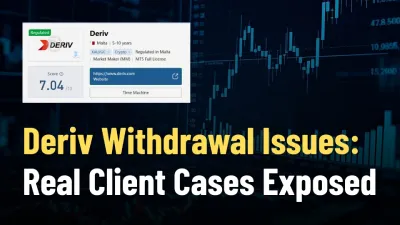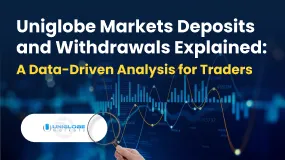简体中文
繁體中文
English
Pусский
日本語
ภาษาไทย
Tiếng Việt
Bahasa Indonesia
Español
हिन्दी
Filippiiniläinen
Français
Deutsch
Português
Türkçe
한국어
العربية
Achieving Financial Security: How To Structure Your Retirement Portfolio
Abstract:Discover how to build a balanced retirement portfolio for financial security. Learn about diversification, asset allocation, and alternative investments with Lawrence Sprung.

Do you know the golden rule of building a retirement portfolio with stocks for passive income? As the founder of Mitlin Financial and author of “Financial Planning Made Personal,” Lawrence Sprung puts it, “Everything is in moderation.” Speaking on Yahoo Finance Live recently, he explained how investors can effectively structure their investment portfolios to enjoy the dividends of passive income during retirement. If you are contemplating how to generate passive income through stock trading and other investments, the WikiFX App can be an indispensable tool in your financial planning arsenal.
Sprung pointed out that investing should not merely revolve around stocks. He emphasized the importance of a balanced portfolio that caters to an individual's risk tolerance and time horizon. Your retirement portfolio should be an amalgamation of various asset classes, including stocks, bonds, total stock market index funds that mirror the complete US market returns, and even a touch of alternative investments.

Amidst the market uncertainties witnessed over the past year, the merits of a diversified portfolio have become more pronounced. However, creating an asset allocation that perfectly aligns with your financial goals requires due diligence and careful consideration of various elements.
“Building out an asset allocation that is right for them includes multiple types of stocks—large-cap, mid-cap, and small-cap. Similarly, bonds could include government and international bonds,” Sprung suggested. He also hinted at the potential of alternative investments, like real estate investment trusts or mutual funds that invest in them, for bolstering retirement income.
In terms of the proportion of your retirement savings allocated to equities, conventional wisdom suggests that the figure should equate to either 100 or 110 minus your age. As an example, a 57-year-old individual with a moderately aggressive risk tolerance might have 65% of her retirement savings invested in stocks and the remaining 35% in bonds. This approach allows her to benefit from the long-term growth potential that stocks generally offer compared to fixed-rate options such as bonds, money market accounts, or certificates of deposit.

Nevertheless, maintaining discipline in your investment approach is essential, especially when the stock market is performing well. Overweighting your portfolio with stocks can leave your savings exposed to significant risks when the market turns bearish.
Aside from stock investments, there are a number of other potential income streams that you can use to supplement your retirement income. These could include a typical pension, an employer-provided retirement plan such as a 401(k), income-producing real estate, or even your own small business. “It's really a flavor for everyone,” Sprung emphasizes, “it's just a matter of finding what's right for you in terms of what your goals are, your risk profile, and your time horizon are.”
Alternative assets, such as real estate, may not appeal to every retiree. Many retirees would rather avoid the problems that come with handling such investments. In such circumstances, real estate investment trusts, which provide ownership in a broad property portfolio as well as the possibility of an income stream, maybe a better option.
However, not all alternative investments are created equal, and some have unique dangers. “Crypto is something that, in most cases, they can easily convert to cash, assuming that crypto is still around and viable,” he explained.

For many retirees, Social Security continues to be a crucial income stream. However, it is projected that Social Security's reserves will be depleted by 2033 unless Congress takes action. With this looming reality, it's imperative for millennials and subsequent generations to start planning alternative income streams for their retirement.
Related news:
Download the WikiFX App to keep abreast of the latest financial news and make informed investment decisions for a financially secure future. Download the app here: https://www.wikifx.com/en/download.html

Disclaimer:
The views in this article only represent the author's personal views, and do not constitute investment advice on this platform. This platform does not guarantee the accuracy, completeness and timeliness of the information in the article, and will not be liable for any loss caused by the use of or reliance on the information in the article.
Related broker
Read more

Check Yourself: The Costly Trading Habits Every Trader Must Fix
Are the trading habits you barely notice the very ones quietly destroying your profits, and could a single overlooked mistake be costing you far more than you realise?

Scandinavian Capital Markets Exposed: Traders Cry Foul Play Over Trade Manipulation & Fund Scams
Does Scandinavian Capital Markets stipulate heavy margin requirements to keep you out of positions? Have you been deceived by their price manipulation tactic? Have you lost all your investments as the broker did not have risk management in place? Were you persuaded to bet on too risky and scam-ridden instruments by the broker officials? These are some burning issues traders face here. In this Scandinavian Capital Markets review guide, we have discussed these issues. Read on to explore them.

Deriv Withdrawal Issues: Real Client Cases Exposed
Deriv exposed via client cases of withdrawal issues, 13‑month refund delays, severe slippage, and disabled accounts despite multiple “regulated” licenses.

Uniglobe Markets Deposits and Withdrawals Explained: A Data-Driven Analysis for Traders
For any experienced trader, the integrity of a broker isn't just measured in pips and spreads; it's fundamentally defined by the reliability and transparency of its financial operations. The ability to deposit and, more importantly, withdraw capital seamlessly is the bedrock of trust between a trader and their brokerage. When this process is fraught with delays, ambiguity, or outright failure, it undermines the entire trading relationship. This in-depth analysis focuses on Uniglobe Markets, a broker that has been operational for 5-10 years and presents itself as a world-class trading partner. We will move beyond the marketing claims to scrutinize the realities of its funding mechanisms. By examining available data on Uniglobe Markets deposits and withdrawals, we aim to provide a clear, evidence-based picture for traders evaluating this broker for long-term engagement. Our investigation will be anchored primarily in verified records and user exposure reports to explain the Uniglobe Mar
WikiFX Broker
Latest News
CFTC Polymarket Approval Signals U.S. Relaunch 2025
MH Markets Commission Fees and Spreads Analysis: A Data-Driven Breakdown for Traders
Alpha FX Allegations: Traders Claim Account Blocks, Withdrawal Denials and Security Breaches
How to Become a Profitable Forex Trader in Pakistan in 2025
Gratitude Beyond Borders: WikiFX Thank You This Thanksgiving
KEY TO MARKETS Review: Are Traders Facing Withdrawal Delays, Deposit Issues & Trade Manipulation?
FCA Consumer Warning – FCA Warning List 2025
Zipphy Exposed: No Valid Regulation, Risk Warning
Australia’s Fraud-Intel Network Exposes $60M in Scams
RM104.9 Million Gone: Why Hundreds Are Demanding a Full MACC Investigation
Currency Calculator




